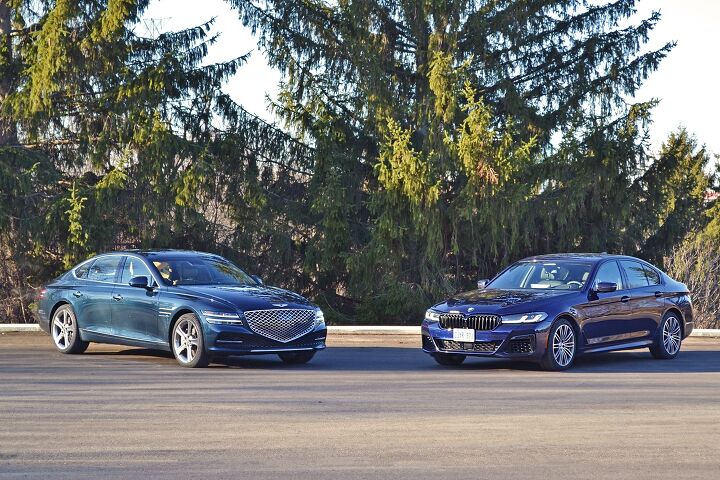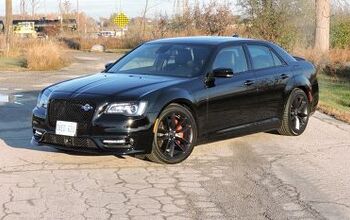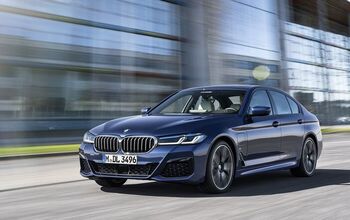Genesis G80 Vs BMW 5 Series Comparison


Learned veteran versus dramatic upstart. It’s a tale as old as time.
The Genesis G80 entered its second generation for 2021. The original was the starting point for the young Korean brand, but started life badged as a Hyundai. This generation ushers in the brand’s Athletic Elegance styling, a dramatic new look that truly sets it apart from the rest of the mid-size luxury sedan. One thing that hasn’t changed is Genesis’ penchant for piling in features to the gunwales, ensuring this well-stocked ride comprehensively out-points the competition, from its sub-$50k starting price ($66,000 CAD) right to the top trim. The latter is what we have here, the top-shelf, AWD 3.5T Prestige.
Get a Quote on a New Genesis G80 or BMW 5 SeriesMeanwhile, the BMW 5 Series needs no introduction. The 5 has been the measuring stick for decades, and BMW gave this G30-generation model a further sprucing up for this year. Cleaner looks and the latest tech keep it fresh against not only the G80, but the updated Mercedes E-Class as well. Our tester is a lightly-optioned 540i xDrive—the six-cylinders have long been the sweet spot of the 5 Series range.
SUVs may be where the market’s at these days, but luxury automakers have built their reputations for driving enjoyment with sedans. Both of these cars carry a considerable amount of their respective brand’s reputations on their shoulders, then. Can the newcomer topple the veteran? Let’s find out.
Styling

G80: Like it or loathe it, everyone has an opinion on the G80. Tasman Blue is the best hue, making an already distinctive car stand out that much more. The short front overhang and coupe-like roofline give it a graceful, clearly rear-driven profile. I know “land yacht” is meant as an insult these days, but there’s something very South-of-France about the G80. Or, as managing editor Kshitij says, it “looks like the kind of car you arrive at a fundraiser in.”
Genesis has worked hard to create a cohesive brand identity, and it’s paid off. The quad-lamp signature at either end makes the G80 identifiable from a mile away. It’s genuinely hard to find a bad angle on this car.

BMW is stuck in a tight spot. On one hand, the new 4 Series is, to put it kindly, challenging to look at. But sticking to the traditional script has the Fiver blending into the crowd. Nobody gave the 540i a second look during the week, but plenty of passersby craned their necks when the G80 floated by.
Bottom Line: If you’re buying a sedan in today’s SUV-crazy market, you want it to make a statement. The G80 does just that.
Interior and Cargo Space

G80: In the automotive world, there are few stronger first impressions than the G80’s cabin. Simply put, this is one of the most impressive interiors you can have for under six figures.
The two-tone interior is warm and inviting. Every piece you touch is high quality, and it’s all screwed together well. The G80 is completely creak- and rattle-free, even across under-construction roads. The dashboard design is minimal, with the vents and a long piece of open-pore wood dividing the colors up. We especially like how the door panel design flows up, into, and around the dash. The intricate stitching on the seats lends a real touch of class to the whole package, too.

Those of us who appreciate physical controls for climate will find dials and a capacitive touch screen—a compromise, sure, but better than touch-only.
There’s just one catch. “It’s ergonomic but given the car’s size you’d want to have little more feeling of space,” says managing editor Kshitij, the G80’s keeper for the week. He praises the front seats’ myriad adjustments, but “the grooves on the front seats takes time getting used to.” The back seats will happily fit full-size adults, and they’ll be plenty comfortable back there. The front and rear seats are heated, while those up front get ventilation, too. A large panoramic sunroof lets in plenty of natural light.
Trunk space stands at 13.1 cubic feet (371 L), slightly less than the boxier 5.

540i: If the G80 interior is expressive and daring, the 540i’s is all business, all the time. The Bimmer’s interior sticks to black, leaving it up to the ambient lighting and sliver of silver on the dash to craft any visual interest. There’s nothing wrong here, and everything is solidly screwed together, but it lacks the all-important wow factor the G80 possesses. Everything is clearly laid out, including the infotainment and climate controls, both of which are canted towards the driver. BMW’s shifter is refreshingly straight-forward to operate as well.
The seats may not look as ornate as the G80’s, but they make up for it with supreme comfort. Kshitij calls the driver’s seat the best he’s experienced in the segment. BMW has aced the balance between long-distance comfort and twisty-road security here. I drove the 540i for nearly 10 hours in a single day ( for a winter driving event) and felt fresh and composed when I got home. The Bimmer gets heated and ventilated thrones up front like the G80 (just heated out back). I find them, as well as the heated steering wheel, quicker to warm up.

Strangely, the BMW feels the more spacious car, at least up front. It isn’t, according to the numbers: with 38.8 inches (986 mm) of front headroom, it gives up 0.6 inches (15 mm) to the Genesis. Rear headroom is tied at 37.5 inches (953 mm). Maybe it’s the smaller steering wheel—even though the cross-section is still too thick. In the back, the Bimmer gives up two inches of legroom, with 36.5 inches (927 mm) playing second fiddle to 38.7 (983 mm). Only the tallest passengers would call that lacking, however.
Trunk space is an even 14 cubes (396 L), giving the Bimmer the edge in the hauling fight.
Bottom Line: This is tough. The G80 goes for the heart with a beautiful interior that feels expensive. That being said, it feels the snugger of the two, even if the tape measure suggests otherwise. Both of these cars will happily whisk their occupants hundreds of miles without issue, but the Bimmer’s riders will be more comfortable. It gets the nod here.
Tech and Features

G80: Genesis debuted a whole new infotainment system with the G80 and GV80, and it’s a good one. Driver and passenger can poke at the 14.5-inch screen if they want, but they’d be missing out on the tactile wonder of the central rotary selector. It’s a joy to spin around, and the responses on-screen are quicker than Disney buying up chunks of your childhood. The graphics are crisp, too.
The head-up display is similarly sharp, though both Kshitij and I wish it were more adjustable via the steering-mounted controls. Genesis’ clever 3D instrument panel is standard on the top trim, adding to the wow factor. A wireless charger works as intended, though the G80 lacks the wireless Apple CarPlay and Android Auto of the Bimmer. You’ll need to plug them in, and you’ll only find USB-A ports to do it, an odd choice on a car new for 2021.
SEE ALSO: 2021 Genesis GV80 Review: Putting ‘Em All on NoticeAudiophiles will appreciate the 21-speaker Lexicon sound system, which is standard on every G80 in Canada (sorry, Americans).
Top trims also include a digital key, which allows owners to share access to their friends without the need for a physical key.

540i: iDrive has come a long way in two decades. This latest iteration is a smooth operator, with intuitive navigation through a combination of taps and rotations of the central dial. It’s still possible to get lost in some of the deeper sub-menus, mind you. As a road tester, my biggest gripe is having to dig to find (and reset) trip information. As in the G80, users can also use the (smaller) touch screen directly. No matter how you interact with it, iDrive is snappy.
BMW also deserves credit for its seamless wireless smartphone pairing. After setting it up once, my iPhone would pair with the 540i before I’d even press the engine start button. Having Spotify immediately resume is a small but welcome feature.
SEE ALSO: 2021 Mercedes-AMG GLE 53 Review: Mild-Mannered Mild-HybridMy questionable music selections sound better in the Genesis, though. The Harman/Kardon system in the Bimmer isn’t bad, but it lacks the power and clarity of the G80’s Lexicon setup.
The digital instrument cluster is easy to read and pleasantly customizable. The distance indicator, which accurately shows what vehicles are around you (and what type) is a welcome touch.
Bottom Line: Like its styling, the G80’s tech suite wows more than the straight-forward lineup in the BMW. Both infotainment systems are very good, but the G80’s extra real estate makes it easier to navigate. The BMW has the better smartphone connection as a counter. Throw in the cool 3D instrument panel and better sound system, however, and the G80 wins.
Powertrain, Driving Feel, and Fuel Economy

The 375-horsepower V6 offers plenty of power from barely over idle well into the mid-range. The transmission doles out the power effectively, though some may find the default mapping ever so slightly slow. Nothing a switch to Sport mode won’t fix. That won’t fix the sound coming from ahead of the cabin: the V6 isn’t a bad singer, but it’s a little industrial compared to the classic Bimmer straight-six.

Steering feel is light; brake pedal feel is good. The G80 is an easy car to get along with, and it will hustle down a backroad with enthusiasm when required. It still feels happiest on quicker, straighter roads, however.
The EPA rates the G80 3.5T AWD at 18 mpg city, 26 mpg highway, and 21 mpg combined. Canadian figures are 12.9/9.0/11.2 L/100 km, respectively.

540i: According to the manufacturers, the 540i is less than an inch shorter than the G80. Its wheelbase, 1.4 inches (36 mm). Yet point it at a wriggly piece of road and the BMW feels at least a foot shorter. There’s an added layer of agility absent from the G80, especially with Sport mode active. The ride firms up, the eight-speed auto keeps the straight-six in the meat of its powerband, and the 540i and the driver simply gel. (Passengers may not enjoy this mode as much.)
Roll everything back and the 540i will happily cruise along. The ride feels slightly firmer than the Genesis, but never close to uncomfortable. Kshitij is a fan of this Jekyll and Hyde duality: “Love how the transmission goes from almost lazy to utterly wired at the push of a button,” reads his note. The steering provides more weighting regardless of mode, and the brake pedal has that top-of-travel firmness that breeds confidence.

The 540i is down on power but never feels it; in fact, the Bimmer felt consistently faster than the G80 in every situation. 335 hp is nothing to sneer at, and the 4.6-second run to 60 mph BMW claims feels right. Plus, you get that classic inline-six snarl.
SEE ALSO: 2020 BMW X3 PHEV Review: Plug-In the One to HaveEPA estimates come in at 23 mpg city, 31 mpg highway, and 26 mpg combined for the 540i xDrive (10.3/7.6/9.1 L/100 km in Canada, respectively).

Bottom Line: It’s a decisive win for the BMW here. If you enjoy driving, the 540i is still the pick. The Genesis is the better cruiser, but the gap isn’t as great on that side. And then there’s the fuel economy; the BMW walks it. The EPA estimating buyers will spend twice as much on gas over five years with the G80.
Safety

G80: Every G80 comes with a comprehensive suite of driver assists. Things like forward collision avoidance, lane-keep assist, blind-spot warning, safe exit assist, rear cross-traffic alert, and Highway Driving Assist II.
The Genesis’ available machine-learning dynamic cruise control is a potentially useful feature. The automaker says the system learns from the driver to then mimic their driving habits. A week wasn’t enough to truly test it, however. But if you drive very aggressively…
Kshitij sings the praises of two optional safety features in particular: Smart Park, and the Blind Spot View Monitor. The former is key for getting in and out of tight spaces (like city-sized garages). The latter is a handy extra set of eyes whenever a turn signal is active, showing a live feed within the instrument panel. In a city full of cyclists, it’s especially useful to get a long view down the sidewalk.

540i: As part of the 2021 refresh, the 540i now includes more active driver assists as standard. These include adaptive LED headlights, automated emergency braking, lane departure warning, and speed limit info. An additional driver assist package ($1,700 / $2,000 CAD) brings in active lane-keep assist, a frontal cross-traffic alert, Active Driving Assistant Pro, and Extended Traffic Jam Assistant. The latter two work in concert to provide partially automated drive support in most settings. The systems work incredibly well, with some of the most natural advanced cruise control we’ve experienced. Operating the system is easy, the instrument panel display is very accurate, and in the event the car believes the driver is incapacitated, it can steer itself to the side of the road and come to a stop.
Bottom Line: It’s the G80 here, no question. While the BMW’s suite works well, buyers still have to pony up for an option package. The 540i is also lacking the clever simplicity of the G80’s Blind Spot View Monitor.
Pricing

G80: Bear with us here, as the G80 lineup is vastly different depending on which side of the 49th Parallel you reside on.
In America, the range kicks off at $48,745 for a rear-drive, four-cylinder G80 Standard, including destination. 18-inch alloys, full LED lighting, parking sensors, dual-zone climate control, heated front seats with driver’s side memory, and an array of safety equipment are all extra. The move up to AWD is a hefty $3,150, though that does add heated rear seats.
The Advanced Package ($53,345) adds in 19-inch wheels, the panoramic sunroof, a powered trunk, three-zone climate control, ventilated front seats, and rockin’ Lexicon sound system. The top Prestige trim ($57,645) includes soft-close doors, full leather seating, 16-way-adjustable Ergo motion seat, wireless charging, remote park assist, 360-degree camera, blind-spot view monitor, and digital key.

Getting into a six-cylinder G80 begins at $60,145. It roughly matches the 2.5T Advanced for content. At the top of the list is the $66,145 3.5T Prestige, getting all the good stuff of our tester, like the 3D instrument panel, suede headliner, and head-up display.
Canadians get just two options: a 2.5T Advanced AWD ($66,000 CAD) and a 3.5T Prestige AWD ($76,000). The Advanced adds the wireless charger and HUD over the US-spec model.

540i: The 2021 5 Series ladder starts with the $55,195 530i ($65,980 CAD, with xDrive). AWD is $2,300 more. That amount of coin nets you 18-inch wheels, power-folding and heated mirrors, leatherette trim, two-zone climate control. BMW offers many of its features in the vast options list, allowing buyers to pick and choose regardless of engine and drivetrain. Want a head-up display on an otherwise stock 530i? It’s part of a $2,700 Premium package ($3,950 CAD).
A 540i xDrive lists for $62,745 ($75,430 CAD). It’s impossible to exactly match our Canadian-spec tester ($89,080 CAD as tested), but you’re looking at roughly $75,000 for everything on offer here.
Bottom Line: No surprise here: the G80 undercuts the 5 Series across the board.
Verdict: Genesis G80 vs BMW 5 Series Comparison

These two cars may exist in the same segment, but they target different buyers. The G80 is the youthful challenger: it doesn’t care for the established norms of the mid-size market, and being a young brand itself, Genesis has the wiggle room to offer a more adventurous package. The 5 Series on the other hand has decades of heritage behind it. It plays to its strengths: a clean, ergonomic cabin, a tuneful inline-six, playful handling—but can’t dare to be more expressive.
Kshitij sums up his feelings: “Want a smooth ride with a rich cabin, that goes well with your Armani tux? Get the Genesis. Want to enjoy a good drive and yet blend in at a business meeting? The Bimmer.”
As good as the BMW is, we’re not ones to blend in. The G80 is our pick out of this duo.
Become an AutoGuide insider. Get the latest from the automotive world first by subscribing to our newsletter here.

Kyle began his automotive obsession before he even started school, courtesy of a remote control Porsche and various LEGO sets. He later studied advertising and graphic design at Humber College, which led him to writing about cars (both real and digital). He is now a proud member of the Automobile Journalists Association of Canada (AJAC), where he was the Journalist of the Year runner-up for 2021.
More by Kyle Patrick





















































































Comments
Join the conversation